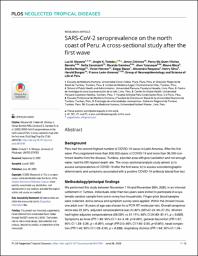| dc.description.abstract | During the first wave, COVID-19 had devastating effects on developing countries like Peru, which reported more than 900,000 cases of the disease and more than 36,000 confirmed deaths from it. The informal settlements are counted in COVID-19 regional statistics, but they are very different from the rest of the region in terms of sanitation, access to water and sewage, housing conditions, and others. To make good decisions about public health, it is important to understand how the disease is spread in informal settlements. We did an observational, cross-sectional study in Puerto Pizarro, a remote port village in Tumbes, from November 11, 2020, to November 30, 2020, to assess the seroprevalence of COVID-19 after the first wave, as well as the sociodemographic factors and symptoms linked to a positive COVID-19 antibody lateral flow test. 1391 people older than 2 years old were given census and symptom questionnaires. They were also tested for the presence of anti-SARS-CoV-2 antibodies (IgG and IgM) in their blood. This study shows an adjusted seroprevalence of 24.82 percent (95% CI 22.49–27.25) posterior to the first wave of COVID-19 in Tumbes. Women had higher adjusted seroprevalence (28.03% vs. 21.11% [95% CI 24.83–31.41], p = 0.002). Extrapolating our adjusted prevalence of 24.82 per 100 persons to Tumbes (N = 251,541), 62,432 people were infected during the first wave, which is too high for adequate primary care in health institutions. Puerto Pizarro’s causespecific mortality rate was 198.49 per 100,000 inhabitants (deaths documented between May and December 2020), which was higher than Tumbes’ up to December 2020 (137.6 per 100,000 inhabitants). The presence of mostly symptomatic patients at health care facilities, the limited use of social networks, the scarce availability of eHealth technologies in government institutions, unused emergency telephone numbers, and the fear of dying if referred to the hospital may have led to underreporting cases. Participation of the community in epidemiological surveillance strategies is critical to assisting the Ministry of Health in the future success of the establishment of an eHealth surveillance monitoring program. | es_PE |


